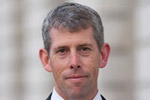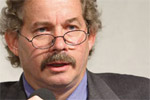Mongabay.com is partnering with the Skoll Foundation ahead of the Skoll World Forum on Social Entrepreneurship to bring a series of perspectives that aim to answer the question: how do we feed the world and still address the drivers of deforestation?
|
HOW DO WE FEED THE WORLD AND STILL ADDRESS THE DRIVERS OF DEFORESTATION? Soy, cattle, rice, palm oil, and logging are the principal drivers of deforestation. As global population increases from 7 billion to 9 billion by 2040, and as more and more people around the world rise out of poverty into the middle class, the demand for these commodities and practices will continue to rise with them. To address these issues, and in advance of the World Forests Summit hosted by the Economist in March, the Skoll World Forum on Social Entrepreneurship partnered with the Stanford Institute for the Environment and Mongabay News to surface the latest insights and innovations at the intersection of deforestation and sustainability. This debate will also set the stage for a larger discussion on deforestation at this year’s Skoll World Forum in Oxford, UK. |
As world population climbs from 7 to a projected 9 billion people and emerging and developing economies demand ever more of the food and fiber that drive deforestation, many environmentalists ask with increasing urgency whether and how tropical forests can survive. But the question may actually be whether and how the world’s increasing, and increasingly rich, population can be fed unless tropical forests survive.
Science has long warned that agricultural output is vulnerable to climate change. Under gradually increasing temperatures, however, many hypothesized that production would decline in some places while rising in others. But extreme weather – like the heat wave in Russia in 2010, last summer’s drought and wildfires in the US and the multi-year drought in Australia – hurts farming everywhere. If, as appears increasingly likely under business-as-usual emissions trajectories, extreme weather becomes the new normal, the world’s food supply could be the big loser.

|
Putting total global greenhouse gas pollution on a fast and steady downward trend may be the only way to avoid serious risk of catastrophic disruption of world food supplies. Tropical deforestation and agriculture together account for about a quarter of GHG emissions in approximately equal proportions. In addition, tropical forests hold some 300 billion tons of carbon. If a big part of this were to go into the atmosphere quickly – should climate change and deforestation-induced drought and runaway fires cause Amazon dieback, for example – this alone could push extreme weather into the realm of the unmanageable. Recent modeling, and research on fire effects in forests suggest that this is an all-too-real possibility. But saving the forest can help feed the world and vice versa.
“To make sure that the deforestation reductions last and do not simply result in emissions shifting to other places, countries or states should show that their deforestation is going down while agriculture production continues or goes up.”
 Steve Schwartzman Director, Tropical Forest Policy, Environmental Defense Fund Steve Schwartzman is Director of Tropical Forest Policy at the Environmental Defense Fund. He leads EDF’s work on tropical forests and economic incentives for large-scale forest protection. For more than 20 years, Steve has worked in the Brazilian Amazon with indigenous and traditional communities, governments, scientists and the private sector to slow deforestation and protect forests. EDF’s Brazilian partners have contributed significantly to Brazil’s dramatic success in reducing Amazon deforestation and establishing ambitious national emissions reduction targets. An anthropologist, Steve lived with the Panará people in the Brazilian Amazon for a year and a half and learned their language. His areas of expertise include tropical forests, Reducing Emissions from Deforestation and forest Degradation (REDD), Brazil and the Amazon, indigenous peoples and incentives for environmental protection. |
The principle is simple – big emitters cap their emissions, put a price on carbon, and meet part of their targets by buying emissions reductions from tropical states or countries that cap their deforestation emissions and that show that they’ve made their reductions targets with robust remote-sensing and field-based measurements. To make sure that the deforestation reductions last and do not simply result in emissions shifting to other places, countries or states should show that their deforestation is going down while agriculture production continues or goes up. Carbon markets – in California, Canadian provinces, Australia, South Korea, the EU, potentially Brazil and other tropical countries as well – can also credit reductions from the adoption of low-carbon agriculture and the restoration of degraded lands (which in Brazil alone cover tens of millions of hectares). For example, there is large potential to increase the productivity of cattle ranching that can increase beef production while reducing pressure to expand into forest areas and keeping emissions of methane, a highly potent greenhouse gas, in check.
Brazil and Amazon states are showing how this can work. Brazil has committed to reducing its Amazon-wide deforestation 80% below the historical (1996 – 2005) average by 2020. It has already reduced more than 70%, or about 2 billion tons, since 2005. And agriculture production has gone up over the same time period, as farmers produce more on less land, and stop clearing new forest. So far, a combination of better law enforcement, credit restrictions on scofflaws, new forest reserves and indigenous territories, and consumer campaigns against deforestation in supply chains, helped by low commodity prices, have held deforestation down. Norway has also committed $1 billion to Brazil’s Amazon Fund if Brazil continues to make its target. But Brazil’s original plan to stop deforestation called for positive incentives for farmers to reduce deforestation. These have not materialized, and the agriculture lobby has pushed back, loosening legal restrictions on forest clearing. We can only sustain and build on climate progress in Brazil — and ultimately, guarantee that the 300 billion tons of carbon in the world’s tropical forest are part of the solution to climate change and feeding the world, rather than part of the problem–if skeptics get proof that emissions reductions from deforestation will pay. Pricing greenhouse gas reductions from forests and other land-based activities within existing and emerging carbon markets can provide the incentives to keep forests standing, protect the climate, and drive the transformation to sustainable, low carbon, high-productivity agriculture in the tropics.
To discuss this commentary, please visit Can Saving Forests Help Feed the World?
|
ALL POSTS IN THIS SERIES
Can we meet rising food demand and save forests? (04/03/2013) A few weeks ago the Skoll World Forum hosted an online debate on how increased global consumption can be balanced with sustainability. The debate asks how a rapidly growing world that is ever consuming can hope to feed everyone, and at the same time address the deforestation that is emitting massive amounts of carbon into the atmosphere and destroying the world’s greatest tropical forests. Many contributors made very strong points—even contradicting one another in their approaches and ideas. Strong ‘no deforestation’ commitments save forests and feed people (03/12/2013) As a global community, we have so far failed to answer this most pressing question; we have yet to build our cloud. Deforestation rates are down in some places, but overall, our forests continue to disappear much as they have for the past 50 years, driven principally by increasing global demand for food. Can we feed the world and save our forests? Yes, we can, and the solution lies in the global supply chain and the message some companies are now sending their suppliers: ‘If you cut down trees, I won’t buy your product.’ This has the power to silence bulldozers. It’s already doing so and now it’s time to go to scale. The need to jump-start REDD to save forests (03/08/2013) At least US$7.3 billion has been pledged for REDD+ over the period from 2008 to 2015, with $4.3 billion pledged for REDD+ readiness during the fast-start period alone (2010-2012). In addition to these funds, private investors, private foundations, and others have been channeling financial support to developing countries for REDD+ and related programs for several years now. A promising initiative to address deforestation in Brazil at the local level (03/05/2013) The history of the Brazilian Amazon has long been marked by deforestation and degradation. Until recently the situation has been considered out of control. Then, in 2004, the Brazilian government launched an ambitious program to combat deforestation. Public pressure—both national and international—was one of the reasons that motivated the government to act. Another reason was that in 2004, deforestation contributed to more than 55 percent of Brazil’s total greenhouse gas emissions, making Brazil the fourth-largest greenhouse gas emitter in the world. Saving forests by putting a price on them (03/04/2013) During the 2013 SuperBowl, the championship game of the US National Football League, a truck company aired an advertisement that likened farmers to God’s favorite assistant. It suggested that when God needs something tough, or gentle, done, he calls a farmer. The narration, taken from a speech given to the Future Farmers of America in 1978 by Paul Harvey, a radio host, plays directly to the near mythical stature of farmers and ranchers in American culture and their deep connection to nature. Saving forests by stemming agricultural sprawl (03/01/2013) I’m fortunate to travel the world helping conserve habitats for some of the world’s most iconic species. When I visit places like the Amazon and Sumatra, I’m still awestruck by their diversity and pristine beauty. I’m also reminded how threatened they are. Our growing demand for food and fiber is fueling deforestation in resource-rich regions of the world. As environmentalists, if we don’t change where and how we produce food and fiber, we can turn off the lights and go home. There won’t be any biodiversity left to protect. Can saving forests help feed the world? (02/28/2013) As world population climbs from 7 to a projected 9 billion people and emerging and developing economies demand ever more of the food and fiber that drive deforestation, many environmentalists ask with increasing urgency whether and how tropical forests can survive. But the question may actually be whether and how the world’s increasing, and increasingly rich, population can be fed unless tropical forests survive. The challenge of putting Brazil’s forests in good hands (02/28/2013) People often associate Brazil with its forests. It’s no wonder given that nearly 60% of the country’s territory is covered by forest and it holds about one-third of the world’s remaining tropical rainforests. You might assume that a country like this would care about educating people to sustainably manage this precious heritage. Well, you’d be wrong! The corporate conservation revolution (02/27/2013) There’s a new kind of environmental hero emerging. They don’t live in Washington, D.C., and they’re known more for their interest in increasing earnings than in reducing greenhouse gases. They are found in an unlikely place: The Corporate Boardroom, and they’re making a big difference in saving the worlds forests and our climate. In recent years, a group of visionary corporate leaders have been quietly teaming up with a growing number of environmental groups to take a hard look at what’s left of our planet’s natural resources. Together, they agree: we are past the point where our land and oceans can meet the food, energy and commodity demands of our planet’s seven billion inhabitants. |
Editor’s note: The opinions expressed in this op-ed do not necessarily reflect the views of Mongabay.com or its staff. Mongabay founder, president, and editor Rhett A. Butler served as an advisor to the Skoll Foundation from 2010-2012.
Related articles








